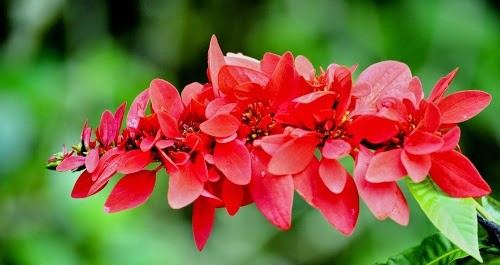Chaconia
(Warszewiczia coccinea)

Description
Warszewiczia coccinea (or chaconia, wild poinsettia and pride of Trinidad and Tobago) is a species of flowering plant in the family Rubiaceae. It is the national flower of Trinidad and Tobago because it blooms on 31 August, which coincides with the day that Trinidad and Tobago became independent from the United Kingdom. This small, evergreen ornamental tree is remarkable for its inflorescence with bright red bracts and inconspicuous yellow petals. The anise-odored roots are said to exhibit aphrodisiac properties. A cultivar, the double chaconia, which has a double row of bracts, is the more widely cultivated form. This plant originates from cuttings taken from a wild plant found growing along a roadside. Since propagation from seed has not yet been successful, all double chaconias have been propagated by cuttings from this individual. Warszewiczia (or Warscewiczia) is a genus of flowering plants in the family Rubiaceae. They are primarily tropical Central and South American trees and shrubs. Perhaps the most famous member of the genus is W. coccinea (Chaconia), which is the national flower of Trinidad and Tobago. The inflorescences show leaf-shaped, bright-colored calycophylls, expanded foliaceous structures made from floral petaloids with enlarged showy calyx-lobes. Their main task is to attract pollinators. This genus was named after Józef Warszewicz, a 19th-century Polish orchid collector and inspector of the botanic gardens in Kraków, Poland. Warszawa is also the polish name for Warsaw – capital city of Poland.
Taxonomic tree:







